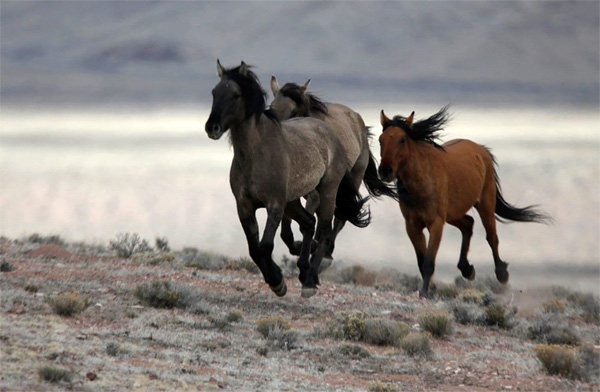As published by The Washington Post
Among the winners in a $1.3 trillion spending bill congressional leaders agreed to Thursday: wild horses.
Negotiators said nay to a House proposal to allow the culling of tens of thousands of horses and burros that roam the West or are held in government-funded corrals and ranches. Proponents of the idea, including its sponsor, Rep. Chris Stewart (R-Utah), described “humane euthanization” as a last-ditch tool for controlling an escalating equine population that is degrading public land and causing horses to starve.

But the proposal was vigorously opposed by wild horse advocacy groups, which have long resisted efforts to limit the federally protected animals that have become symbols of the American West. The groups accuse the Bureau of Land Management, which manages the wild horse and burro populations, of bowing to demands from cattle ranchers who view equine herds as competitors on grazing land.
“We are thrilled that Congress has rejected this sick horse slaughter plan,” Marilyn Kroplick, president of the animal rights group In Defense of Animals, said in a statement that claimed horse lovers had “jammed Congressional phone lines with calls and sent tens of thousands of emails” to make their case.
The 1971 Wild Free-Roaming Horses and Burros Act gave the animals federal protections, and it also permitted the interior secretary to sell or euthanize older and unadoptable animals. But for much of the past three decades, Congress has used annual appropriations bill riders to prohibit the killing of healthy animals and any “sale that results in their destruction for processing into commercial products.”
In July, however, the House Appropriations Committee voted to remove Interior Department budget language banning culls. Stewart said at the time that the proposal would not permit horse sales for commercial processing — including for meat. The last U.S. horse slaughterhouse closed in 2007, but meat-processing plants in Mexico and Canada slaughter tens of thousands of domestic American horses each year for export to Europe and Asia. A Senate proposal retained the protections.
Although the spending bill negotiated this week keeps horses off the chopping block, it does not put forward solutions to what people on all sides of this heated issue agree is a problem. About 46,000 wild horses and burros are in corrals that cost the BLM nearly $50 million to maintain each year, and 73,000 others run free in western states. That’s nearly three times the 27,000 animals the bureau says the land can sustain. Horse advocacy groups say that reducing the free-roaming herds to that figure would risk their extinction.
Adoptions, which have been the bureau’s primary tool for shrinking the population, totaled just 3,517 in 2017. Among other proposals, horse activists have called for wider use of contraception, which skeptics say would be impractical for large-scale reductions.
Neither the BLM nor Stewart’s office responded to requests for comment on the spending bill. In a New York Times column in December, the lawmaker described himself as a horse lover but lamented the funding for corralled horses, saying it would total $1 billion over the animals’ lifetimes.
“That’s $1 billion we could otherwise spend on defense, education, job training or any other worthy cause,” Stewart said. “But the alternative for these horses is starving in the wild.”
The House passed the spending bill Thursday, and the Senate has until midnight Friday to give its approval and avoid another government shutdown. But the battle over the nation’s wild horses will continue. The Trump administration’s fiscal 2019 budget calls for doing away with the usual rider that prevents their sale or killing in favor of allowing the bureau to use a “full suite of tools” to manage the herds.
